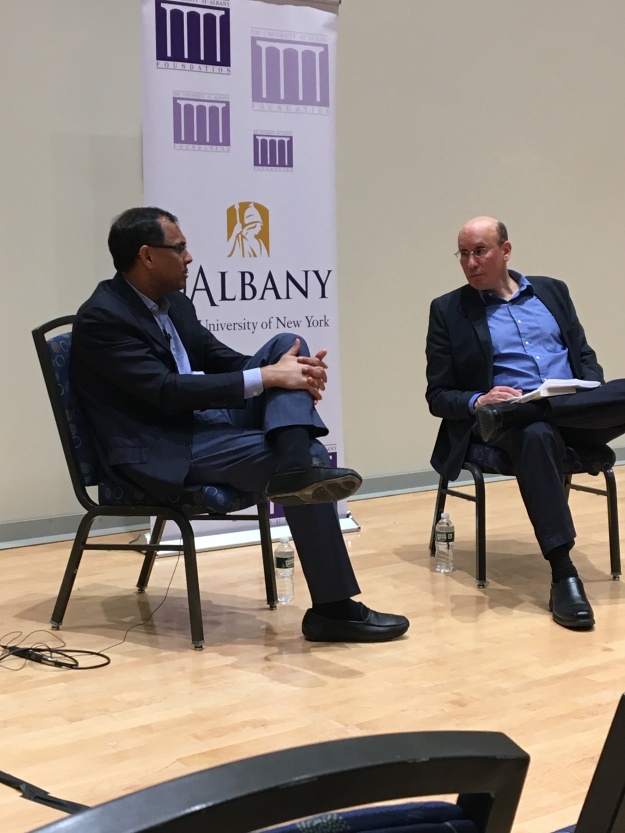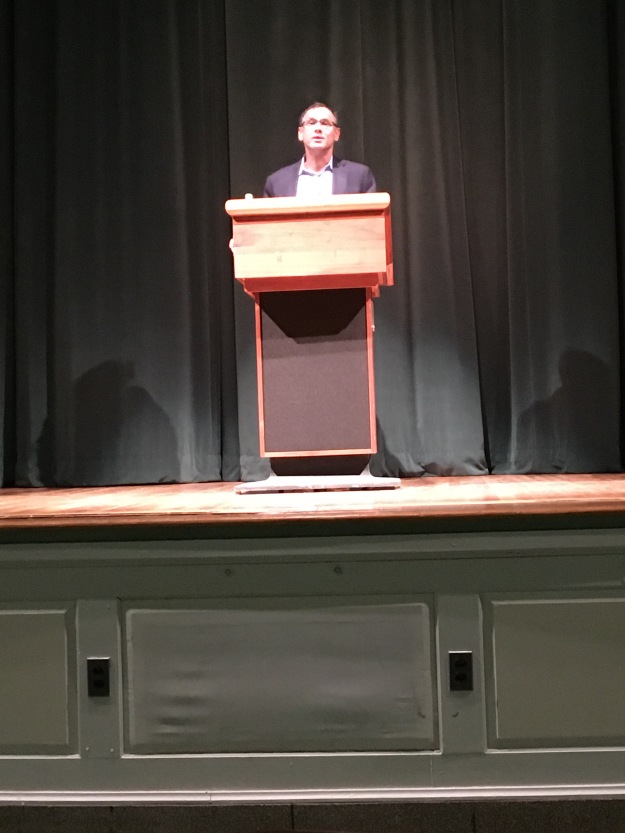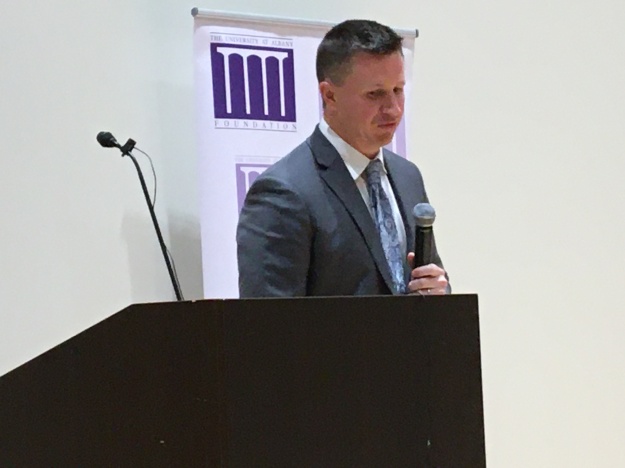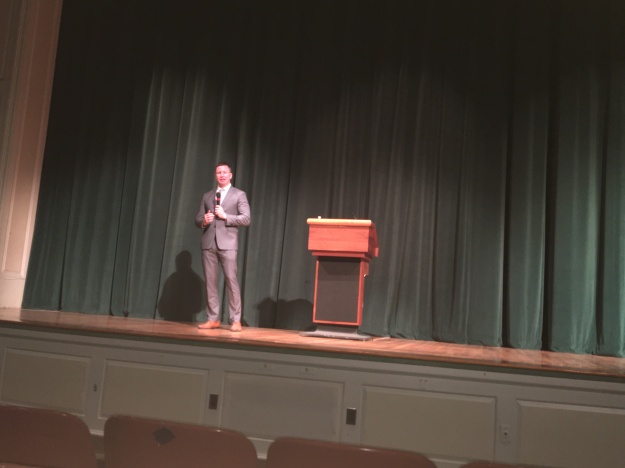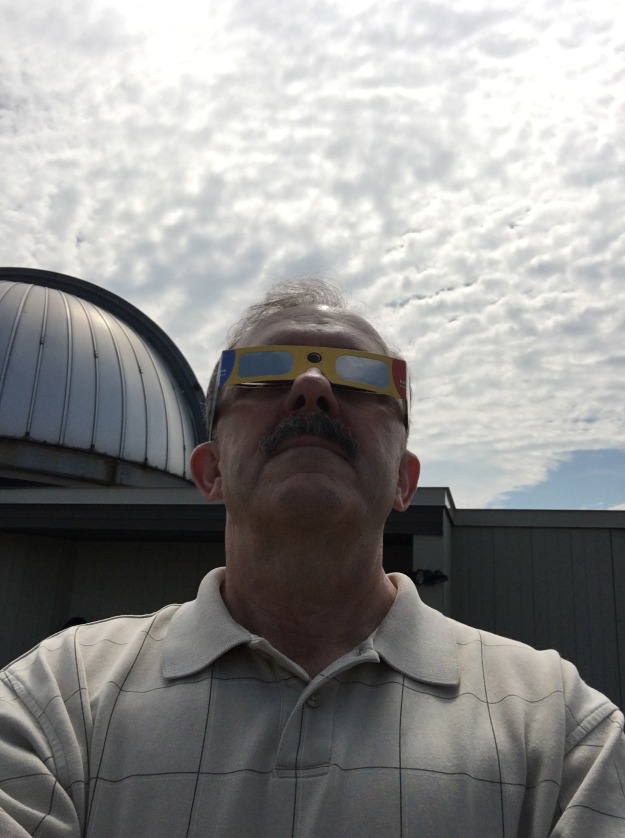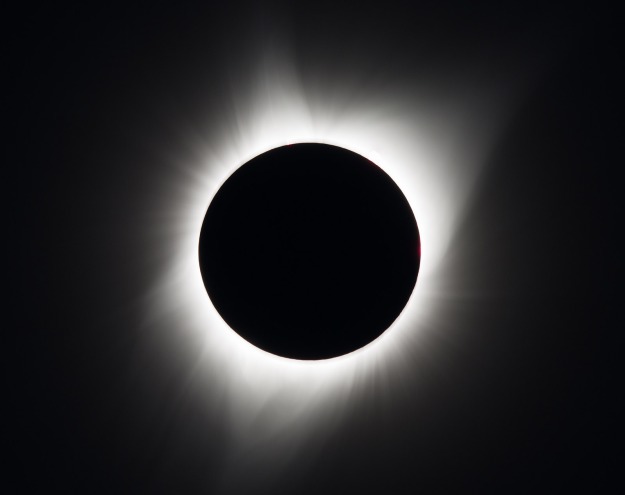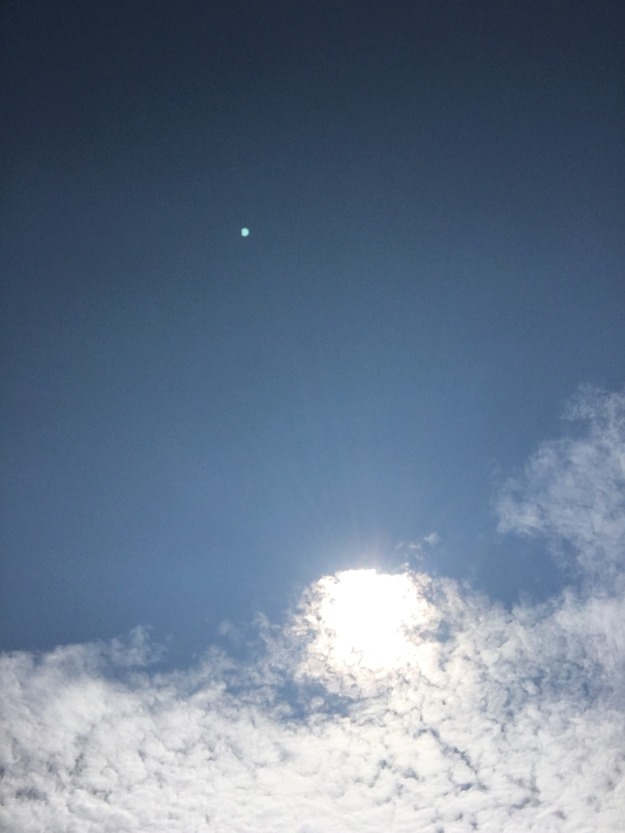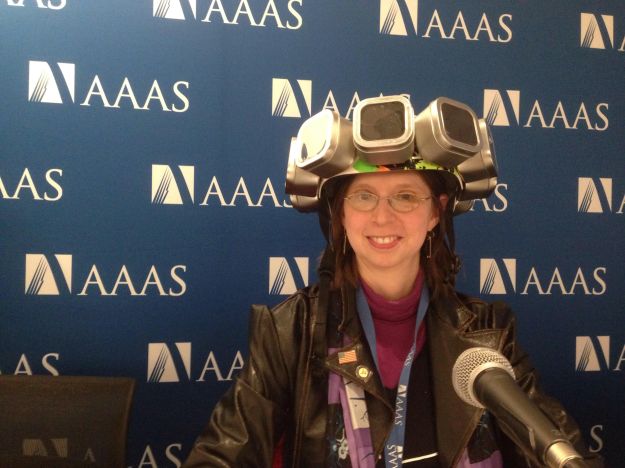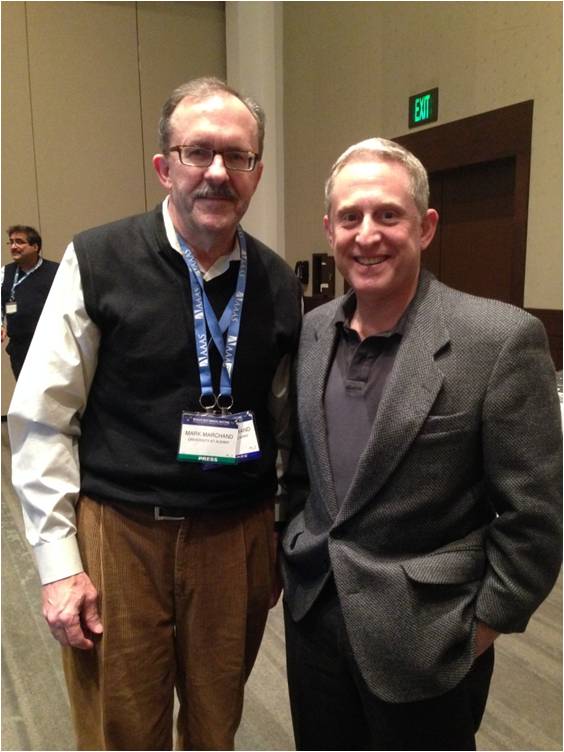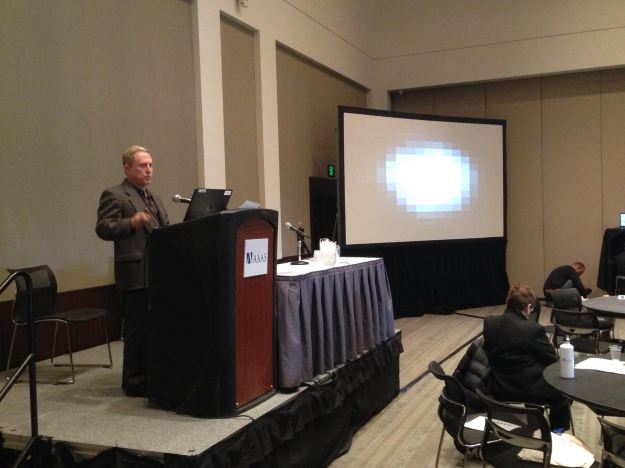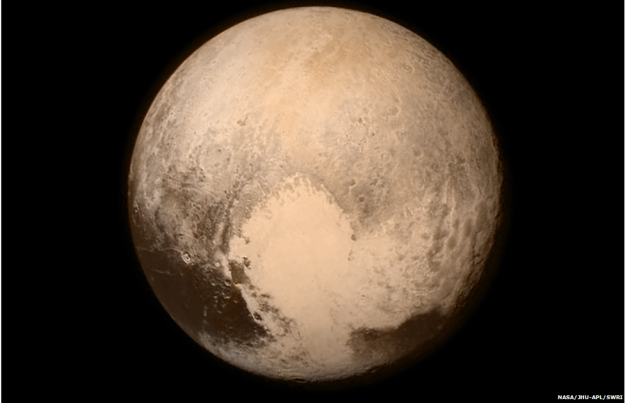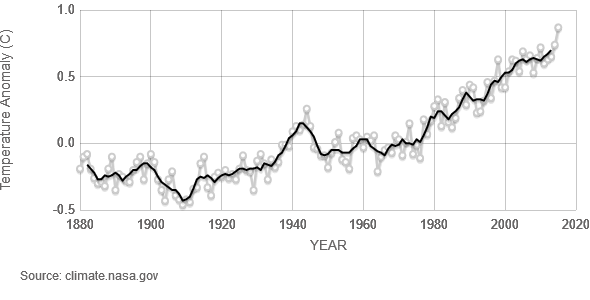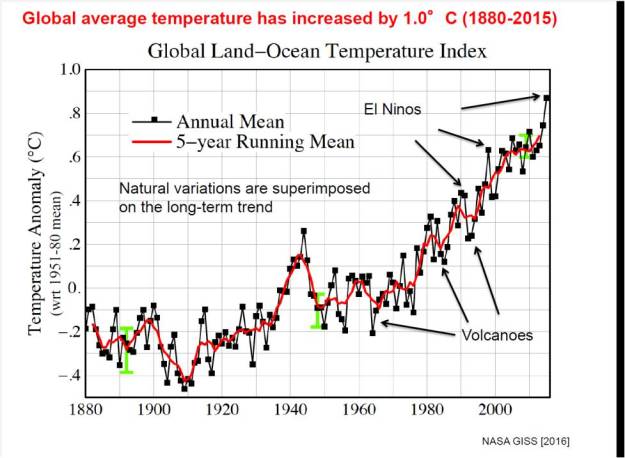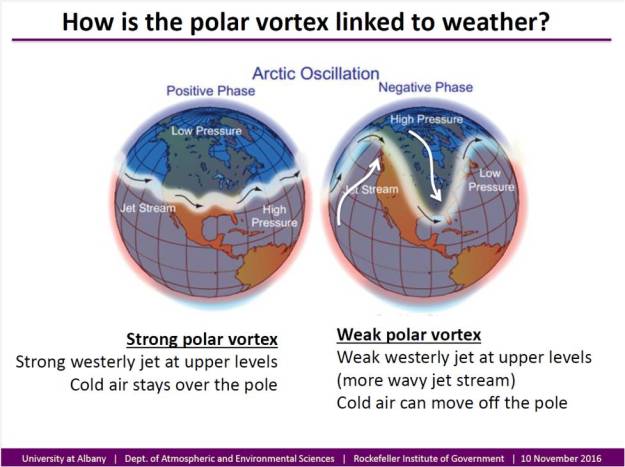By Mark Marchand
A set of bridges sits just south of where I live in Saratoga County, north of Albany. The small suspension spans carry interstate highway traffic across the Mohawk River between Albany and Saratoga counties. The bridges are formally known as the singular Thaddeus Kascsiusko Bridge, but most locals know them simply as “The Twin Bridges,” or even “The Twins.” I’ve gone along with this for years, but I’ve always felt twins was a better moniker for two not-that-similar looking, historic bridges that link lower Manhattan with Brooklyn.
Viewed via Google Maps from high above, the celebrated Brooklyn Bridge and its lesser known — but no less fascinating — partner The Manhattan Bridge form a loose “V” where they land within a few blocks of each other in Brooklyn. Since they are so close, they are my twin bridges.
I have hurtled over both while seated comfortably in cars, windows closed and oblivious to the sights and sounds associated with the crossing. But after years of reading about the Brooklyn Bridge and its storied history — combined with my lifelong love of bridges as engineering and construction marvels — I resolved to walk at least the Brooklyn Bridge, both ways. I ended up adding the Manhattan bridge for the westbound return trek after reaching Brooklyn, almost as an afterthought … but I was glad I did.
Setting off
In the fall of 2012, I pick a beautiful, sunny Sunday and head to Manhattan via Amtrak early in the morning. Since the Manhattan entrance for the Brooklyn Bridge eastbound is near New York’s City Hall and several miles from Penn Station, I take a taxi over. I want to save my legs for walking both bridges.
Departing from the cab, I plunge into a crowd of walkers milling about taking pictures of City Hall and other landmarks in City Hall Park. The aging, red-gray towers and shiny cables of the Brooklyn Bridge rise to my left. I head there right away.
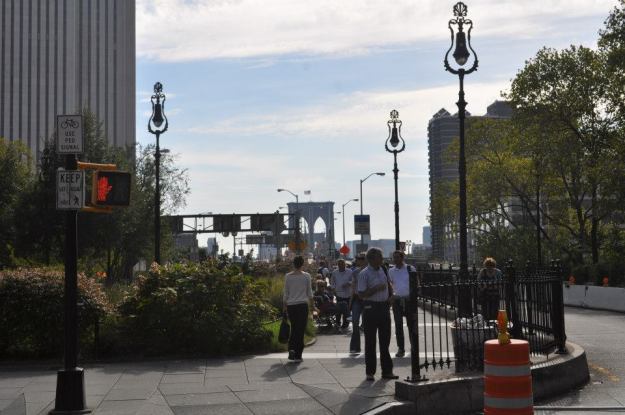
Entrance to Brooklyn Bridge, from the Manhattan side, near City Hall.
There’s lots of construction going on. Concrete Jersey barriers line the right side of the cement, upsloping entrance walkway. Farther up the ramp where the actual bridge begins, eight-foot steel barriers associated with the construction block my view of the East River on each side of the walkway. Yet I can finally see the lattice-work of steel cables rising above me and soaring to the first of the two main towers. From my vantage point where the concrete footpath turns into the wood planks of the actual bridge walkway, I can see the top of the first of the two towers with the year it was built, 1875, displayed between peaks of the two arches that soar close to the top. A large American flag sits atop the tower, flapping gently out toward the left in the light, southerly breeze.
At last I break free from the construction barriers and the full effect of walking the bridge settles in. To my right and left and below the walkway, cars and trucks stream past in both directions. About 100 feet farther below, the choppy, blue waters of the East River flow from left to right enroute to the Upper Bay, beneath the long and towering Verrazano Narrows Bridge, and, finally, into the Atlantic Ocean.
Geometry and engineering on full display
No matter how often you stare at pictures of this more-than-century-old bridge, you’re not prepared for being surrounded by a spectacular geometric feature. A spider-web-like array of steel cables that seemingly extends in all directions surrounds each side of the walkway. Some of the cables rise straight up, connecting to the thick main suspension cable that extend from ground level on each side before rising to the top of the two towers. Other cables crisscross those vertical wires at different angles and head forward to connect directly with the granite/cement/limestone towers. The net result is that pedestrians and cars/trucks are funneled through a complex labyrinth of cables that is unlike any other bridge ever built. On this morning, rays from the rising sun glint off the hundreds of cables, sparking a constant flickering as I continue my walk east, up toward the first tower nearest Manhattan.
These cables made the Brooklyn Bridge the first steel-wire suspension bridge in the United States, when it opened in 1883.
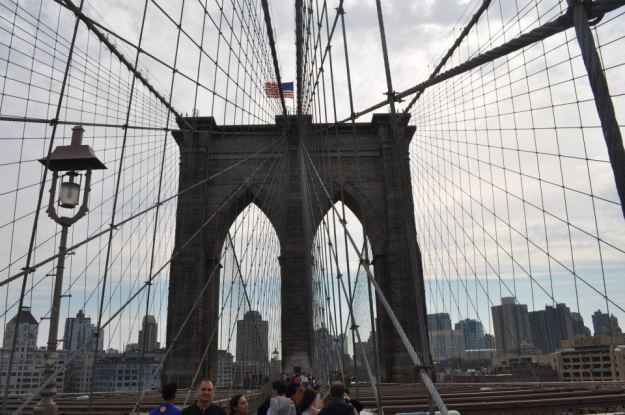
The spider-web-like array of cables supporting Brooklyn Bridge.
I am not alone on this Sunday morning. Hundreds of other walkers , most of whom seem headed from Brooklyn toward Manhattan, crowd the wooden walkway. A white line is painted down the middle. Walkers are supposed to stay on one side and bicyclists on the other. I witness many near collisions as cyclists wander from their space to pass slower riders, while lost-in-thought amblers or young children stray into the paths of bicycles. Cyclists are constantly ringing their bike bells to clear traffic.
Approaching the first tower, I hear snippets of different languages from my fellow walkers. Expressions of wonder in Chinese, Arabic, French, Spanish, Italian, and other languages swirl around. We’re not far from Ellis Island in New York Harbor, so I’m reminded that well into the 21st century New York City retains its status as the nation’s great melting pot. On this day, I take comfort in that fact.
Almost everyone walking the bridge today is taking pictures: selfies, selfies with selfie sticks, group photos, pictures of the Manhattan skyline, tower pictures, and photos of the Statue of Liberty in the distance to our right and the Manhattan Bridge to our left. The clear blue sky is perfect for photos so I join the effort. Some of my best pictures prove to be of the receding Manhattan landscape, with a still under-construction Freedom Tower beginning to poke above its neighbors.
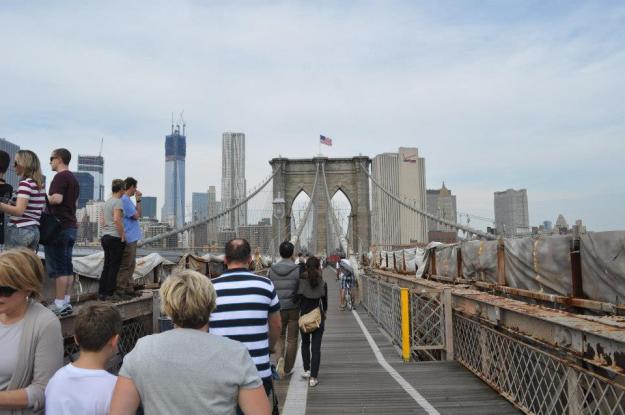
Looking back at Manhattan. For the most part, cyclists stayed on one side; pedestrians on the other.
After passing the first tower, with the walkway still sloping upward, I pause to look back at the nearly 300-foot supporting structure. Did those construction workers and engineers in the 1870s, I ask myself, understand their work would still be standing and serving the traveling public well into the 21st century? The nation was still healing from the end of the brutal Civil War in 1865, and inventions like the telephone were just arriving. How can this bridge be so old and still working while many of the bridges we built since the late 1800s and much more recently only survive 50 years or so before needing major repair work or replacement? That fact alone makes this bridge so impressive.
Some vendors have appeared now. They’re hawking t-shirts, cold drinks, and souvenirs. I’m amazed by the cleanliness. No graffiti. Little or no trash. And I get the feeling I could even make this walk at night and feel safe. To walk the Brooklyn Bridge is to experience a collective warmth and kinship with those out simply to walk a bridge. The roar of traffic beneath us continues, joining in with the clip-clop of hikers wearing harder shoes and the voices of hundreds enjoying the walk and sparkling weather.
After peaking near the middle of the span and starting downhill toward Brooklyn and the second supporting tower, I keep pausing to look back for breathtaking views of Manhattan. I finally give up and capture a selfie or two. Nearing the end of the over-one-mile span I’m back on a long, curving concrete walkway that guides me to Brooklyn streets. I can’t help but chuckle to myself when I spot a cute message on a Brooklyn welcome sign: “How sweet it is!” It bears silent testimony to the pride and cockiness for which many Brooklynites are known.
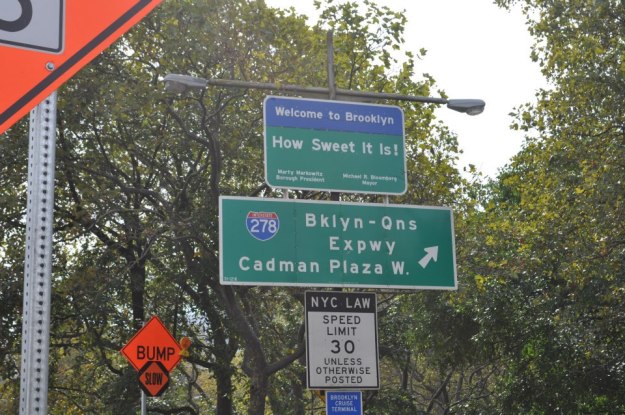
Entering Brooklyn.
About 90 minutes after starting the walk and at a traffic light where the bridge ramp ends, I turn left on Tillary Street and then left again on Jay Street to navigate to where the Manhattan Bridge begins. A few minutes later, I scramble up some steps to join the concrete walkway on the south side of this second bridge.
Return via the Manhattan Bridge
The visual difference between both suspension bridges is immediate and jarring. Where the Brooklyn Bridge oozes quaint beauty and a friendly, embracing feeling, the Manhattan Bridge appears at first to be harsh, metallic, and isolated from the rest of the city. From what I can see at the beginning, I am the only one on the walkway. I am so alone, in fact, I am a bit afraid. It is immediately apparent to me that fewer people walk this bridge.
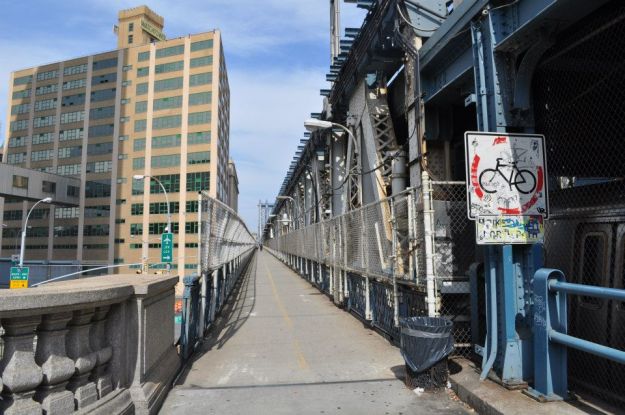
Entering the walkway on the Manhattan Bridge, to return to Manhattan. Subway cars to the extreme right.
The concrete/asphalt walkway is bordered on each side by older, rusty chain-link fencing. Unlike the Brooklyn Bridge, it’s difficult to see the bridge structure and towers due to the closed-in nature of the path. I spot the first evidence of graffiti, which becomes much worse as I near Manhattan. Walking up toward the first tower, a loud sustained rattling and whooshing noise envelopes me. Turning to my right, through the fence I see subway cars speeding by. They are so close, the breeze they create knocks my hat off and stirs up dust and trash. My cursory pre-walk research had failed to reveal that in addition to the seven lanes for cars and trucks on top, the middle level of the bridge has four subway tracks. I wonder how the bridge structure handles the constant banging and rocking from the heavy subway cars.
Approaching the first tower, I crane my neck upward. I can’t see much from my position. Vertical cables rise to meet the main, bridge-long cables that connect with the tower, and I can see the top of the almost Gothic-like tower. Not much else.
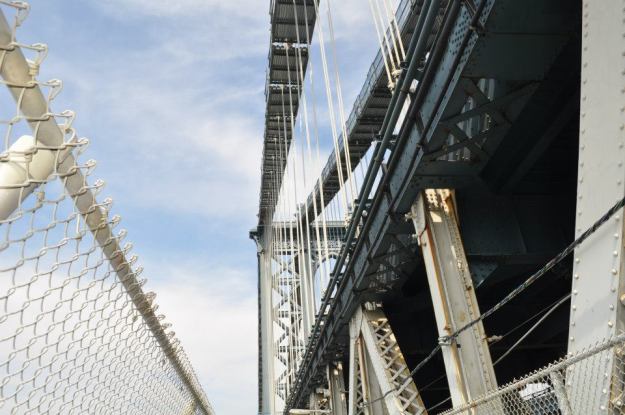
Approaching the first Manhattan Bridge tower.
Halfway across the Manhattan Bridge, I’m still alone. Looking left I discover stunning views of the Brooklyn Bridge I just crossed. I crouch to poke my camera through a gap in the fence to take some of what I feel are the best bridge pictures I’ve ever seen.
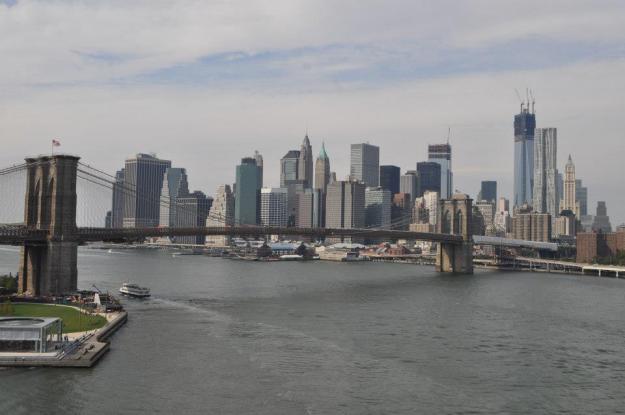
View of the Brooklyn Bridge, looking south from the Manhattan Bridge.
Still alone and nearing Manhattan, I stop to take pictures of a large collection of graffiti covering some cement columns and wall on my left. They are colorful and they appear new. Ahead of me, I spot my first fellow walker.
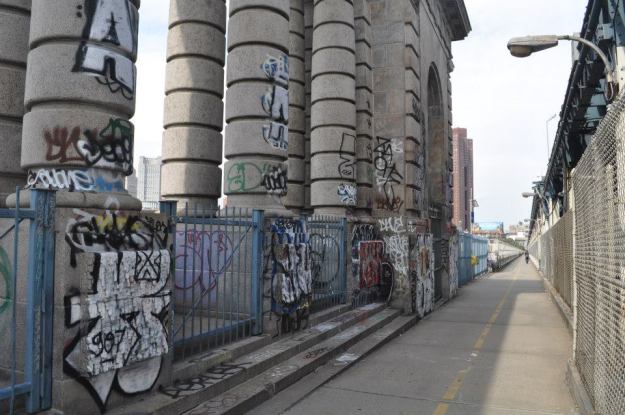
Some graffiti on the Manhattan Bridge, something not seen much on the Brooklyn Bridge
The 6,800-foot-long Manhattan Bridge — opened in 1909 after eight years of construction — returns me to the city’s most well-known borough on the north side of Chinatown. From the ramp leading down into Manhattan, I can see numerous softball teams enjoying Sunday-morning games on artificial turf diamonds that are squeezed into sparse real estate in dense neighborhoods. Brick apartment buildings are everywhere. I’m tired now, so I wander around Chinatown until I find a good restaurant where I can sit and eat lunch.
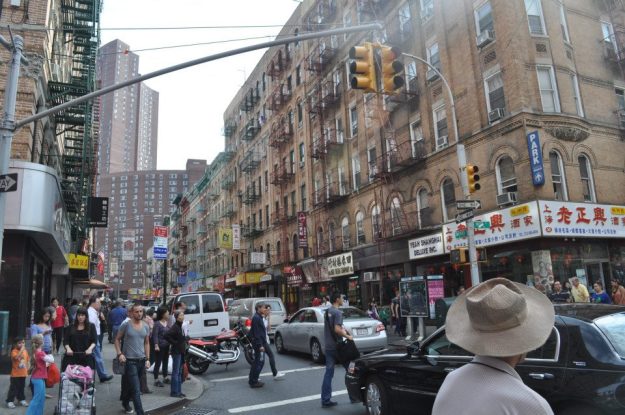
Chinatown in lower Manhattan.
Taking stock of my progress while eating, I find that walking both bridges involved about 7,000 steps, or approximately 3.4 miles over two hours. To me it was everything I expected and much more.
My strength returns after lunch, so I decide to skip the cab and walk the several miles back up to Penn Station, via Canal Street and right onto Broadway north through the trendy, artsy Soho neighborhood. Twenty blocks later, where Broadway crosses 14th Street, I’m tired again but stunned back into reality with the most unexpected visual treat of my walk: Union Square Park.
The six-acre commons with a multi-tiered plaza on the south side and trees to the north is teeming with people from all walks of life. Jugglers. Young and older couples. Scampering children. Street musicians. Souvenir vendors. Sixties-era hippies. Magicians. Dancers. I stumble into the middle of it all and I’m jostled from time to time. My senses are overloaded, and I’m developing a headache. I spot a man dressed as a devil, complete with horns, carrying a cross and a sign asking everyone to repent. Atop the steps to an elevated plaza, a well-dressed man waves a baton, conducting a silent orchestra. Yet in the midst of all this commotion, some park visitors sit quietly on steps, reading books, smart phones, and newspapers.
It’s as if someone took a huge funnel and dumped a sampling of New York City into one place on this sunny afternoon. Later, on the train home, I struggle to capture in writing my impressions of the park, but mostly fail. I regret not stopping to take some pictures of Union Square.
I allow myself to be pushed along by the throng, finally reaching the north side of the park at 17th Street. I speed up again and complete another 20 blocks, arriving at Penn Station a half hour before my train leaves.
Sitting on the train and drinking a cold beer to cool down, I check my pedometer again. Walking from Chinatown to the train station took about 6,800 steps, or 3.3 miles. The total walking distance for the day was about seven miles. Yet in those seven miles I feel like I’ve seen so much more than I could have witnessed on any similar-length walk, anyplace. Not uncommon when one walks New York City.
Somewhere around Yonkers, I make a few notes and start reflecting on my day. My bridges walk ended up being my favorite New York City walk then, and it remains so today. I’m planning more, and I will be back.
###
